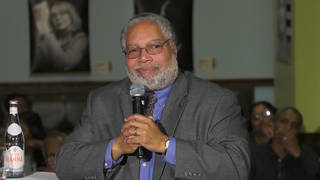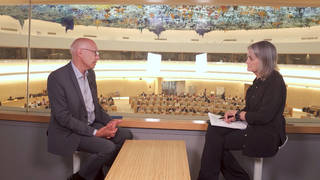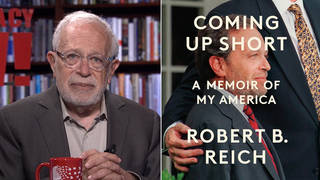
Topics
Guests
- Karen Ishizukathird-generation American of Japanese descent who was part of the Asian American movement in Los Angeles. She was the curator of the nationwide exhibit called “America’s Concentration Camps: Remembering the Japanese-American Experience.” Her latest book is titled Serve the People: Making Asian America in the Long Sixties. She is also the author of Lost and Found: Reclaiming the Japanese American Incarceration.
- Richard Reevesauthor of several books, most recently, Infamy: The Shocking Story of the Japanese-American Internment in World War II. He is the senior lecturer at the Annenberg School for Communication and Journalism at the University of Southern California.
As Secretary of State John Kerry visits Hiroshima, Japan, site of the 1945 U.S. nuclear attack which killed 140,000 people, most of them civilians, we turn to another choice the United States made during its fight against Japan in World War II—the decision to imprison 120,000 Japanese Americans in internment camps across the U.S.—and ask: Could something like this happen again? The 2016 presidential campaign has been marked by calls from Republican candidates to create a database of all American Muslims and to have the police patrol Muslim neighborhoods. Cruz’s proposals came after Republican presidential front-runner Donald Trump told Time magazine last year he did not know if he would have supported or opposed Japanese-American internment camps had he been a leader during World War II. We speak with Richard Reeves, an award-winning journalist and the best-selling author of several books, most recently, “Infamy: The Shocking Story of the Japanese-American Internment in World War II,” and with Karen Ishizuka, a third-generation American of Japanese descent. She was the curator of the nationwide exhibit called “America’s Concentration Camps: Remembering the Japanese-American Experience.” Her latest book is titled “Serve the People: Making Asian America in the Long Sixties.”
Transcript
AMY GOODMAN: This is Democracy Now!, democracynow.org, The War and Peace Report. We’re on the road as part of our 100-city tour, now in Los Angeles, California. I’m Amy Goodman.
Secretary of State John Kerry is in Japan today, where he’s become the first sitting U.S. secretary of state to visit Hiroshima, where he went to the atomic bomb memorial commemorating the 1945 U.S. nuclear attack, which killed 140 [thousand] people in Hiroshima. The United States is the only country in the world to drop an atomic bomb, first in Hiroshima August 6, 1945, then in Nagasaki three days later. Kerry described the memorial, saying, quote, “It reminds everybody of the extraordinary complexity of choices in war and of what war does to people, to communities, to countries, to the world.”
Well, we’re going to turn now to another choice the United States made during its fight against Japan in World War II: the decision to imprison 120,000 Japanese Americans in internment camps across the U.S. Could something like this happen again? The 2016 presidential campaign has been marked by calls from Republican candidates to create a database of all American Muslims and to have the police patrol Muslim neighborhoods. Following the Brussels attacks last month, Republican presidential contender Ted Cruz sparked widespread controversy by saying, quote, “We need to immediately halt the flow of refugees from countries with a significant al Qaida or ISIS presence. We need to empower law enforcement to patrol and secure Muslim neighborhoods before they become radicalized,” end-quote. Senator Cruz later doubled down on these calls in an interview on CNN.
SEN. TED CRUZ: If you have a neighborhood where there is a high level of gang activity, the way to prevent it is you increase the law enforcement presence there, and you target the gang members to get them off the streets. … I am talking about an area where there is a higher incidence of radical Islamic terrorism. If you look at Europe, Europe’s failed immigration laws have allowed a massive influx of radical Islamic terrorists into Europe, and they are now in isolated neighborhoods where radicalism festers.
AMY GOODMAN: Among the many to criticize Cruz for these statements was California Democratic Congressman Mark Takano, whose parents were placed in Japanese internment camps during World War II.
REP. MARK TAKANO: As I watch leading politicians propose discriminatory policies targeting the Muslim community, I cannot be silent. Seventy years ago, my parents and grandparents were held prisoner in—during World War II without trial and without a reason other than their Japanese heritage. In that moment, no one was willing to speak up for them. We cannot ignore the lessons of history. The Muslim community is the most frequent victim of terrorism and our greatest ally in ridding the world of extremism. Responding to Brussels by advocating for patrols of Muslim neighborhoods or suggesting that we torture our enemies is not only counterproductive, it violates the moral code that separates us from our enemies.
AMY GOODMAN: Senator Ted Cruz’s proposals came after Republican presidential front-runner Donald Trump told Time magazine last year he didn’t know if he would have supported or opposed Japanese-American internment camps had he been a leader during World War II, saying, quote, “I would have had to be there at the time to tell you.” But he’s called for a comprehensive database of all American Muslims, a ban on Muslims entering the country and a wall to be built along the entire length of the Mexico border.
Meanwhile, Democratic Mayor David Bowers of Roanoke, Virginia, also sparked outrage last year after he used the internment of Japanese Americans during World War II as a positive precedent to justify suspending the resettlement of Syrian refugees in his city. He said, quote, “I’m reminded that President Franklin [Delano] Roosevelt felt compelled to sequester Japanese foreign nationals after the bombing of Pearl Harbor, and it appears that the threat of harm to America from Isis now is just as real and serious as that from our enemies then,” he said.
Well, to talk more about one of the most shameful chapters in U.S. history, we’re joined by two guests: Richard Reeves, award-winning journalist, best-selling author of several books, most recently, Infamy: The Shocking Story of the Japanese-American Internment in World War II; also with us, Karen Ishizuka, a third-generation American of Japanese descent, the curator of the nationwide exhibit called “America’s Concentration Camps: Remembering the Japanese-American Experience.” Her latest book is titled Serve the People: Making Asian America in the Long Sixties. She also wrote Lost and Found: Reclaiming the Japanese American Incarceration.
We welcome you both to Democracy Now! Karen Ishizuka, you say it’s wrong to refer to what happened to the Japanese as “internment.” Why?
KAREN ISHIZUKA: Well, I think that, you know, as both George and others have called it internment, because that’s the common phrase, I don’t—
AMY GOODMAN: George?
KAREN ISHIZUKA: George Takei and others.
AMY GOODMAN: George Takei, who is the star in Star Trek.
KAREN ISHIZUKA: Right, right.
AMY GOODMAN: Japanese American.
KAREN ISHIZUKA: Yeah, yeah. But I think, you know, when I was asked to curate the show, Asian—that we ended up calling “America’s Concentration Camps,” you know, I had 19 advisers, including Roger Daniels, the historian, who was probably one of the first major historians to write about the camps, as well as Aiko Herzig-Yoshinaga, who was the lead researcher on the Commission for the Relocation and Internment of Civilians for the government. And all of those 19 advisers advised us to not continue to use euphemisms that have been used throughout the history of the United States to mitigate, basically, what had happened during World War II to Japanese Americans. So—
AMY GOODMAN: What happened exactly?
KAREN ISHIZUKA: Well, you know, people say that 120,000 people were interned, but the internment refers to a parallel but different set of incarceration under the international laws, so only so-called enemy aliens, including Germans, Italians and Japanese, were so-called interned in internment camps. And that was about 7,000 or 8,000. In the meantime, there was a Commission on War Relocation Authority, set up 10 camps that they euphemistically called relocation centers, but that are now called concentration camps, because FDR himself first called them concentration camps. So, it’s not that the Japanese-American community started that phrase; it was—really came from the government itself. So, we were advised, and we continue to not use euphemisms such as “internment” for “incarceration,” “relocation center” for “concentration camp.”
AMY GOODMAN: I wanted to correct something I said earlier about the atomic bombing of Hiroshima. The U.S. dropped that bomb on Hiroshima and killed not 140 people, but 140,000 people. Now, Richard Reeves, I wanted to ask you about your book, Infamy.
RICHARD REEVES: Right.
AMY GOODMAN: Why—you’ve written many books on many subjects, including on the Clintons, but why you chose to focus on what happened to Japanese Americans?
RICHARD REEVES: Because I think it could—could happen again to Muslims, to border crossers, and I wanted to do my bit to try to make that not happen. But I do think a few incidents—the Supreme Court never ruled that the laws the White House and the military used to incarcerate these people—that’s still on the books. As Justice Jackson, Robert Jackson, said, it’s a loaded gun on the Constitution, so that I had—I’m amazed at how few people, once you get east of the Sierras and the Cascades, really know or believe this happened.
AMY GOODMAN: Who was questioning whether the military had the right to do this at the time?
RICHARD REEVES: No one was questioning. It was all internal dialogue between the Justice Department, the War Department and the president.
AMY GOODMAN: And what do you make of—
RICHARD REEVES: And then there was—there was great speaking of words. There were great disputes, internal, on—until they came up with a statement that avoided using the words that partly drove the incarceration. That is, race and greed. Japanese Americans or Japanese are never mentioned in Executive Order 90—1066—
KAREN ISHIZUKA: 9066.
RICHARD REEVES: —which Roosevelt signed, partly under the tutelage of Roger Baldwin of the American Civil Liberties Union, who was saying—these were the people you would think would rise up.
AMY GOODMAN: The ACLU.
RICHARD REEVES: Yes. But Baldwin was a great friend and supporter of Roosevelt, and he forbade his people to talk about race in this sentence. The order doesn’t say race, but it was only the Japanese Americans who were rounded up. And they—but they were never used, the real words.
AMY GOODMAN: And where were they held?
RICHARD REEVES: First—yeah.
AMY GOODMAN: I mean, for people who are not Japanese-American—
RICHARD REEVES: Right.
AMY GOODMAN: —this is a very little-known chapter of American history.
RICHARD REEVES: Yes, unfortunately, because it’s also a continuum, beginning with the treatment of the Tories, or the Indians, before that, after the Revolution, and “Irish need not apply” and anti-Semitism. And the other has always been discriminated against, if they came as we needed the labor. They built the country. But the—and then they were discriminated against, because they weren’t us, until they were us. And now they are us. As to what happened, there were—they established a war zone along the Pacific Coast, claiming—there was great fear, proclaiming that the Japanese, imperial Japanese, could invade the West Coast. Actually, Roosevelt and his people knew they didn’t have the capacity to do that, but he wanted that issue off the boards, and also so that—they were first rounded up and kept usually at racetracks. Santa Anita had 18,000 Japanese Americans held in there, as did other racetracks, livestock fairgrounds. That’s where they put them for four or five months, while they built, from prisoner of war camp plans, the relocation centers or the camps in 10 different places around the country.
AMY GOODMAN: California; Arkansas; Santa Fe, New Mexico—
RICHARD REEVES: Santa Fe was not—was not a camp. Santa Fe was a federal prison.
KAREN ISHIZUKA: Well, that’s why, you know, sort of the difference between incarceration and internment comes up, because Santa Fe was an internment camp, and there were—my grandfather was interned in Santa Fe before he was released and sent to Arkansas to join the rest of my family. But I think that’s where it gets difficult to accurately talk about the era, because of the continued use—and I noticed that you, you know, used the term “internment.” And I have to also make a correction, that, you know, I know that George Takei was one of the few who’s been—you know, stood up to Donald Trump and asked him to really stand up for his words, but, you know, I am not sure whether he uses the term “internment” or “incarceration.” But he was part of the Japanese American National Museum board when I did the “America’s Concentration Camps” and was really one who stood up for our right to tell the story, our history, the way it was experienced.
AMY GOODMAN: Karen Ishizuka, what was the role of the U.S. Justice Department in all of this? I mean, it was the military that was rounding people up. What about Justice?
KAREN ISHIZUKA: You know, even when I was doing the exhibit and I called the Justice Department, even they did not have a complete list of so-called internment camps. I think everything happened so fast, and so one hand didn’t know what the other was doing. So the Justice Department was, from my understanding, in charge of the internment and of the so-called enemy aliens. So, you know, as I mentioned, both Japanese Americans as well as Italians and Germans were—
RICHARD REEVES: The military handled the camps. Many people in the Justice Department were against the roundup, as it were, but their voices were stilled. Some people quit over it. But Roosevelt wanted it, and he got it.
AMY GOODMAN: And ultimately, what happened? When were Japanese Americans freed? Their property gone? And what has happened since?
RICHARD REEVES: Well, I would begin by saying that 75 percent of the net worth of the Japanese community, in California, at least, disappeared. On December 8th of 1941, the day after Pearl Harbor, Japanese-American bank accounts were frozen, so that they couldn’t pay mortgages. They couldn’t pay insurance. And then the attorney general of California, Earl Warren, and his department ruled that their property was abandoned property, and either sold or distributed it to their Caucasian neighbors. It was—it was an outrage.
AMY GOODMAN: And finally, your final words, Karen, on this, as we wrap up our discussion?
KAREN ISHIZUKA: Well, I think that, you know, there is still discussion. Like you said, most people, many people still don’t know what happened. I think that it’s—
AMY GOODMAN: The compensation awarded to Japanese Americans how many decades later and what it was?
KAREN ISHIZUKA: So, your question is about camp or about the reparations?
AMY GOODMAN: Just compensate—the reparations.
KAREN ISHIZUKA: Reparations. That, you know, there was an attempt for reparations way back, right after the war, in the ’50s, if I remember correctly. But they were also asked at that time to produce receipts of what was lost, etc. So, it was a big fight, and it came from the community itself. And it was something that even Japanese Americans—my parents, for example—did not want to talk about. It was a shameful—and, you know, in terms of blaming the victim, they really felt that, you know, let bygones be bygones.
AMY GOODMAN: The government thought.
KAREN ISHIZUKA: And Japanese Americans, as well. But I think, you know—and that’s what part of—
AMY GOODMAN: We have five seconds.
KAREN ISHIZUKA: And we needed to bring out the truth and ask our parents to really talk about what had been covered up.
AMY GOODMAN: Well, we’re going to leave it there, but it certainly won’t be the last time we discuss this. Richard Reeves, author of Infamy: The Shocking Story of the Japanese-American Internment in World War II, and Karen Ishizuka, third-generation American of Japanese descent, who was part of the Asian American movement in Los Angeles.












Media Options